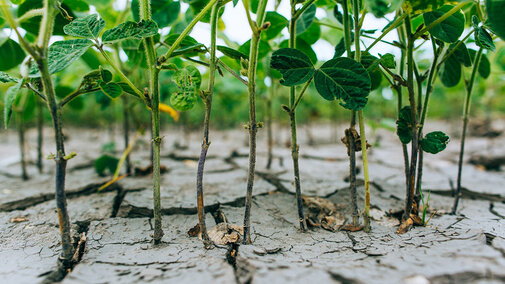Alfalfa Evaluation and Renovation
Were you expecting more from your alfalfa yields this year or had a disappointing spring seeding? Is it time to renovate or move on?
Before we make any decisions, measuring our stand to accurately determine health is our first step. We can either measure plants or stems per square foot, but stem count will more accurately predict yield. To assess, take a 17x17-inch square or a 19-inch diameter circle and set it down in a field. Count the plants or stems that would be harvested, then divide those by two to get stems or plants per square foot. Do this in several spots around the field for accurate assessment.
For established stands, four to five healthy plants per square foot or 55 stems per square foot warrants a productive and healthy stand. Stem counts below 55 see a significant decrease in dry matter production.
For spring established stands, 10-15 plants per square foot is a perfectly healthy stand as the alfalfa begins to age. Plants will continue to branch out, so 35-55 stems per square foot is the goal at this point.
If our stand does appear to be lacking, we have a few options. In fields established this spring, alfalfa autotoxicity has not yet set in, so interseeding thin patches is an option. For older fields, interseeding with a high-quality forage grass may be a way to maintain productivity for a few more years. Orchard grass is a tried-and-true option to consider but remember grass/alfalfa mixtures are very limited for weed control options. For either alfalfa or a grass, plan on drilling seeds rather than broadcasting for proper establishment.
Soybeans for Forage
By Brad Schick
With drought plaguing Nebraska and surrounding states this year, producers may want to salvage soybeans as forage instead of for grain. Many can remember when soybeans were only used for forage many decades ago, so it can definitely be done.
Grazing, haying or ensiling can all be done with soybean plants. Grazing is very simple and has a relatively low risk of bloat; however, if there are many bean seeds themselves, high oil consumption can cause issues in cattle, especially calves. Young calves should not be allowed access to beans. For mature cattle, providing some grass hay can help reduce this risk. Use strip grazing to force the use of the entire plant.
Hay from soybeans will have a similar quality to that of alfalfa. However, drying and rolling up hay is difficult with soybeans. The leaves become very fragile while the stems can take a long time to dry. Crimp the stem heavily and resist the urge to rake the windrow unless done only one day after cutting to limit leaf shatter.
Soybean silage is easier than haying. The moisture content needs to be between 60% and 70%. In the past, soybean silage has been packing while corn silage is being packed at a ratio of one ton soybean silage to three or four tons corn silage. This improves fermentation and will make the overall silage pile have higher crude protein. If doing only soybean silage in a pile, wait until the leaves begin to turn yellow and be sure to use an inoculant. Adding a bushel of rolled corn per ton of silage can help fermentation and as always, be sure to get a very good pack.
Using soybeans other than for grain can be done. Be sure to make a plan and stick to it for the best results.
Late Season Grasshopper Control
In the summer of 1874, Nebraska was experiencing an extreme drought, not unlike the conditions the state is experiencing this year. Despite this, crops were growing and families were hopeful, until July. From the west came a cloud that blocked out the sun and sounded like a storm: locusts.
These were Rocky Mountain Locusts, relatives of grasshoppers, which had descended on the Great Plains from Colorado, Wyoming and Montana in numbers nearing the trillions. Not only were crops eaten to the ground, but clothes were reportedly consumed from farmers’ backs and trains were halted due to the sheer number of locust bodies being crushed under their wheels.
This account is no doubt unsettling; however, such swarms are no longer a threat in Nebraska. Ultimately, the Rocky Mountain Locust was eradicated from North America by 1902, due primarily to western development.
While we no longer need to worry about locust swarms that fill every corner of the sky, current drought conditions throughout much of Nebraska has created an environment conducive to grasshopper movement into crops from field edges. It is important to note, however, that grasshopper presence does not necessarily indicate a need for treatment. By conducting visual counts or using a sweep net, you can determine if the threshold of 15-20 nymphs or 8-10 adults per square yard has been reached in your field.
If grasshopper levels have reached threshold, treatment with an insecticide may be feasible as long as pre-harvest intervals are considered. Many insecticides used for other insects in alfalfa and other forages are also labeled for grasshoppers. Please be especially careful to avoid injuring bees and other important pollinating insects when using insecticides and carefully read and follow all label directions.
It's also important to remember that our goal isn’t to completely eradicate grasshoppers from our fields, but to reduce their numbers to below threshold levels and give our crops a chance to “win the race” against pests.

